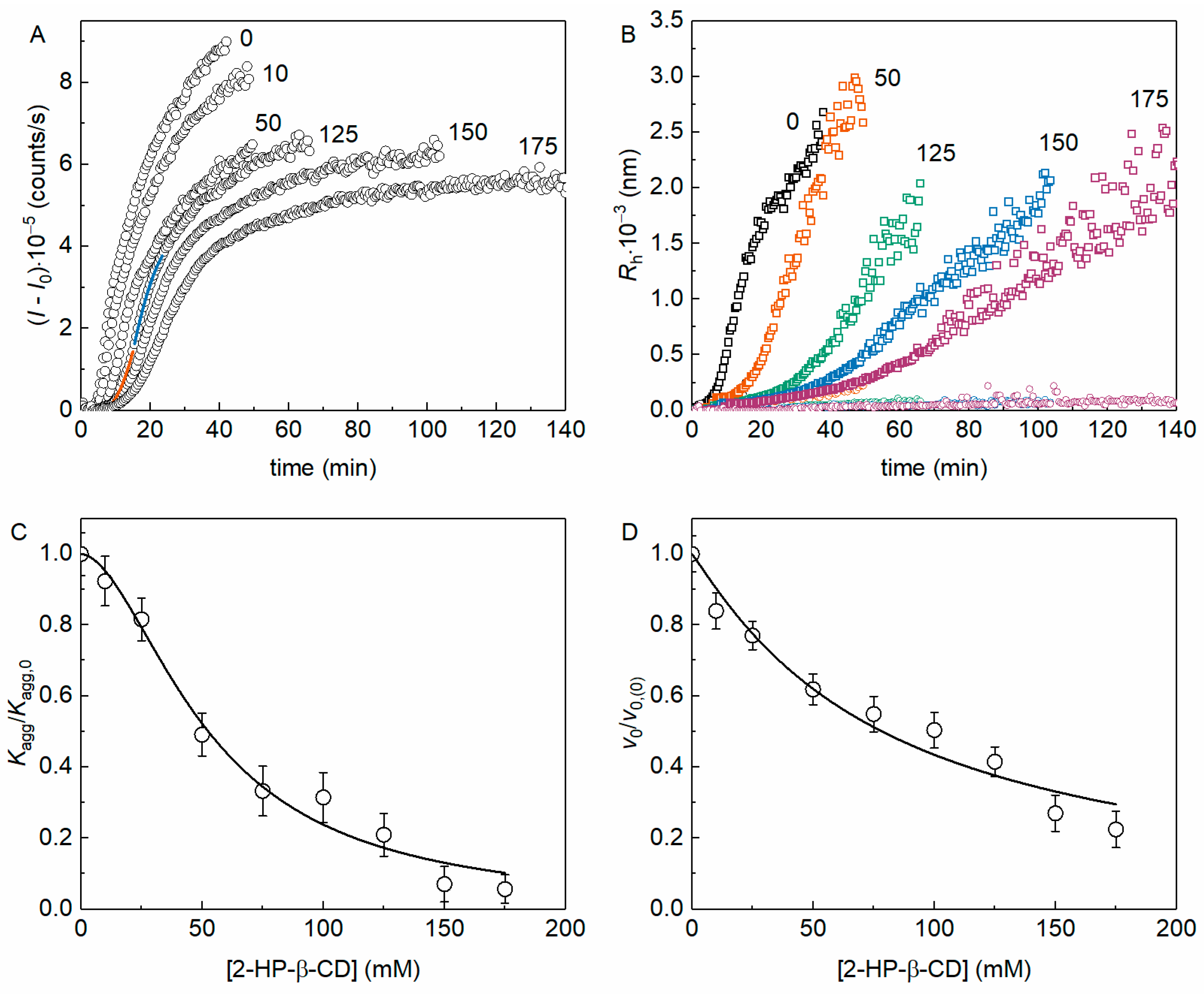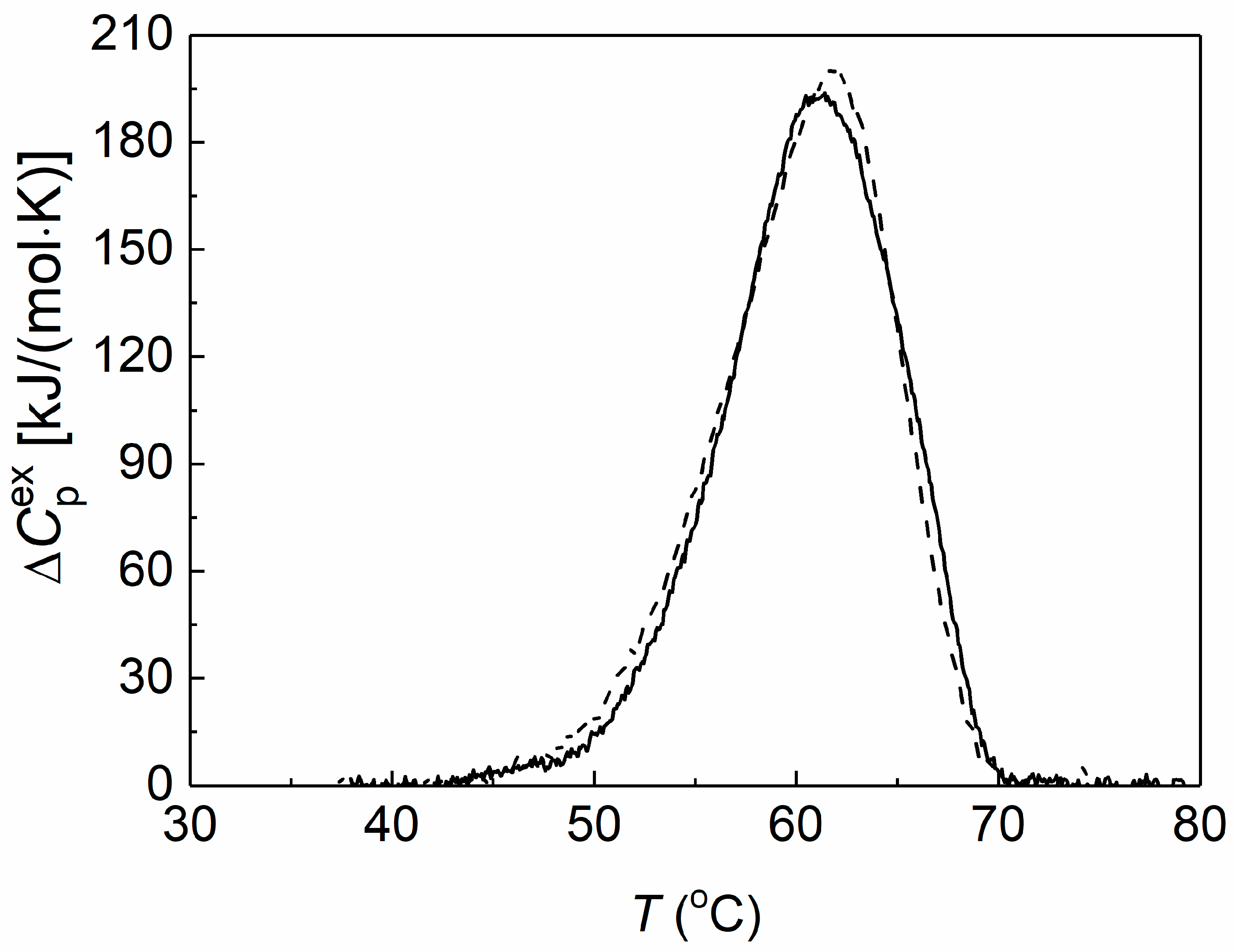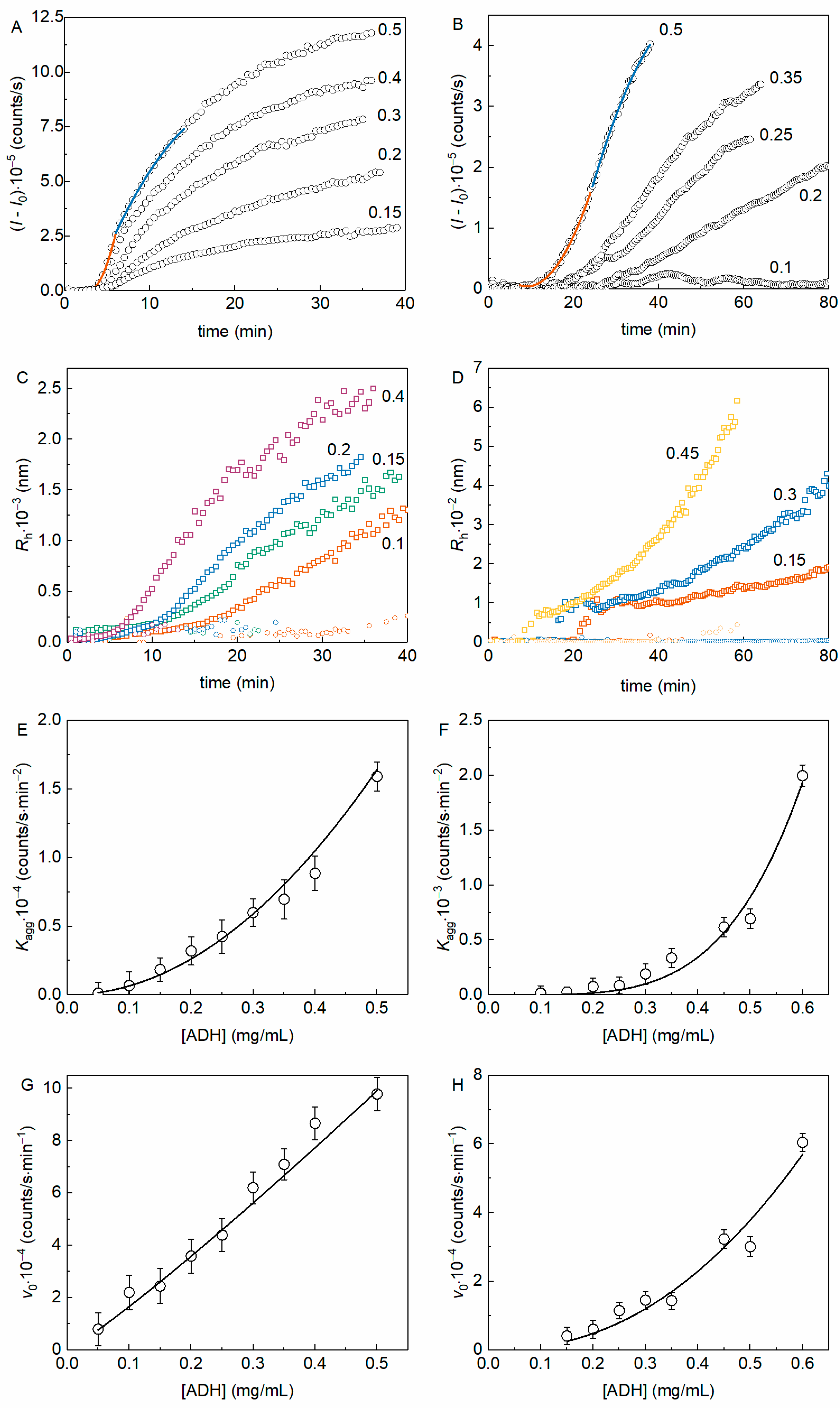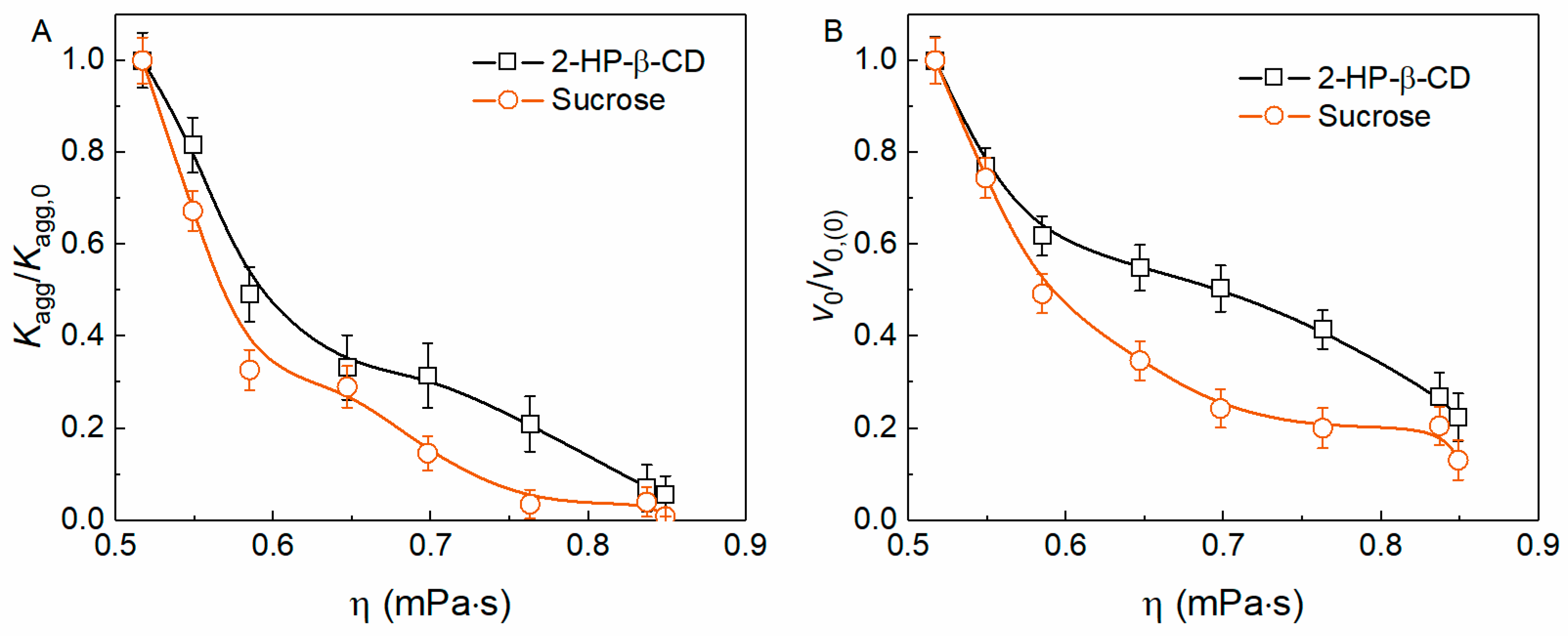Change in the Kinetic Regime of Aggregation of Yeast Alcohol Dehydrogenase in the Presence of 2-Hydroxypropyl-β-cyclodextrin
Abstract
:1. Introduction
2. Results
2.1. Effect of 2-HP-β-CD on the Kinetics of Thermal Aggregation of yADHp
2.2. Effect of HP-β-CD on the Thermostability of yADHp
2.3. The Change in the Kinetic Regime of yADHp Aggregation in the Presence of HP-β-CD
2.4. The Change in the Aggregation Pathway of yADHp in the Presence of 2-HP-β-CD
2.5. The Zeta Potential of yADHp Aggregates in the Presence and in the Absence of 2-HP-β-CD
2.6. The Effect of Solution Viscosity on the Kinetics of yADHp Aggregation
3. Discussion
4. Materials and Methods
4.1. Materials
4.2. Purification of the Stable Fraction of yADH
4.3. Differential Scanning Calorimetry (DSC)
4.4. Dynamic Light Scattering (DLS)
4.5. Refractometry, Densitometry and Viscosimetry
4.6. The Determination of the Portion of Non-Aggregated Protein
4.7. Zeta Potential Measurements
4.8. Data Analysis
5. Conclusions
Supplementary Materials
Author Contributions
Funding
Institutional Review Board Statement
Informed Consent Statement
Data Availability Statement
Acknowledgments
Conflicts of Interest
References
- Ferrone, F.A.; Hofrichter, J.; Sunshine, H.R.; Eaton, W.A. Kinetic studies on photolysis-induced gelation of sickle cell hemoglobin suggest a new mechanism. Biophys. J. 1980, 32, 361–380. [Google Scholar] [CrossRef] [PubMed]
- Arvinte, T.; Cudd, A.; Drake, A.F. The structure and mechanism of formation of human calcitonin fibrils. J. Biol. Chem. 1993, 268, 6415–6422. [Google Scholar] [CrossRef] [PubMed]
- Buell, A.K. The nucleation of protein aggregates—From crystals to amyloid fibrils. Int. Rev. Cell Mol. Biol. 2017, 329, 187–226. [Google Scholar] [CrossRef] [PubMed]
- Borzova, V.A.; Markossian, K.A.; Kleymenov, S.Y.; Kurganov, B.I. A change in the aggregation pathway of bovine serum albumin in the presence of arginine and its derivatives. Sci. Rep. 2017, 7, 3984. [Google Scholar] [CrossRef]
- Raj, S.B.; Ramaswamy, S.; Plapp, B.V. Yeast alcohol dehydrogenase structure and catalysis. Biochemistry 2014, 53, 5791–5803. [Google Scholar] [CrossRef]
- Magonet, E.; Hayen, P.; Delforge, D.; Delaive, E.; Remacle, J. Importance of the structural zinc atom for the stability of yeast alcohol dehydrogenase. Biochem. J. 1992, 287, 361–365. [Google Scholar] [CrossRef]
- De Bolle, X.; Vinals, C.; Prozzi, D.; Paquet, J.Y.; Leplae, R.; Depiereux, E.; Vandenhaute, J.; Feytmans, E. Identification of residues potentially involved in the interactions between subunits in yeast alcohol dehydrogenases. Eur. J. Biochem. 1995, 231, 214–219. [Google Scholar] [CrossRef]
- Thudi, L.; Jasti, L.S.; Swarnalatha, Y.; Fadnavis, N.W.; Mulani, K.; Deokar, S.; Ponrathnam, S. Enzyme immobilization on epoxy supports in reverse micellar media: Prevention of enzyme denaturation. J. Mol. Catal. B Enzym. 2012, 74, 54–62. [Google Scholar] [CrossRef]
- Ghannadi, S.; Abdizadeh, H.; Miroliaei, M.; Saboury, A.A. Immobilization of alcohol dehydrogenase on titania nanoparticles to enhance enzyme stability and remove substrate inhibition in the reaction of formaldehyde to methanol. Ind. Eng. Chem. Res. 2019, 58, 9844–9854. [Google Scholar] [CrossRef]
- Han, P.; Song, X.; Wu, H.; Jiang, Z.; Shi, J.; Wang, X.; Zhang, W.; Ai, Q. Enhancing catalytic activity and stability of yeast alcohol dehydrogenase by encapsulation in chitosan-calcium phosphate hybrid beads. Ind. Eng. Chem. Res. 2015, 54, 597–604. [Google Scholar] [CrossRef]
- Luo, Y. Yeast alcohol dehydrogenase can be used as a supramolecular assembly agent for fabricating Ru(bpy)32+-containing luminescent materials towards solid-state electrochemiluminescene detection application. Inorg. Chem. Commun. 2009, 12, 588–590. [Google Scholar] [CrossRef]
- Forti, J.C.; Aquino Neto, S.; Zucolotto, V.; Ciancaglini, P.; de Andrade, A.R. Development of novel bioanodes for ethanol biofuel cell using PAMAM dendrimers as matrix for enzyme immobilization. Biosens. Bioelectron. 2011, 26, 2675–2679. [Google Scholar] [CrossRef]
- Umasankar, Y.; Adhikari, B.-R.; Chen, A. Effective immobilization of alcohol dehydrogenase on carbon nanoscaffolds for ethanol biofuel cell. Bioelectrochemistry 2017, 118, 83–90. [Google Scholar] [CrossRef]
- Klinman, J.P.; Welsh, K. The zinc content of yeast alcohol dehydrogenase. Biochem. Biophys. Res. Commun. 1976, 70, 878–884. [Google Scholar] [CrossRef]
- Markossian, K.A.; Golub, N.V.; Khanova, H.A.; Levitsky, D.I.; Poliansky, N.B.; Muranov, K.O.; Kurganov, B.I. Mechanism of thermal aggregation of yeast alcohol dehydrogenase I: Role of intramolecular chaperone. Biochim. Biophys. Acta Proteins Proteom. 2008, 1784, 1286–1293. [Google Scholar] [CrossRef]
- Yang, Y.; Zhou, H.M. Effect of zinc ions on conformational stability of yeast alcohol dehydrogenase. Biochemistry 2001, 66, 47–54. [Google Scholar] [CrossRef]
- Szejtli, J. Introduction and general overview of cyclodextrin chemistry. Chem. Rev. 1998, 98, 1743–1753. [Google Scholar] [CrossRef] [PubMed]
- Duchêne, D.; Bochot, A. Thirty years with cyclodextrins. Int. J. Pharm. 2016, 514, 58–72. [Google Scholar] [CrossRef] [PubMed]
- Rincón-López, J.; Almanza-Arjona, Y.C.; Riascos, A.P.; Rojas-Aguirre, Y. When cyclodextrins met data science: Unveiling their pharmaceutical applications through network science and text-mining. Pharmaceutics 2021, 13, 1297. [Google Scholar] [CrossRef] [PubMed]
- Nishijo, J.; Tsuchitani, M. Interaction of L-tryptophan with α-cyclodextrin: Studies with calorimetry and proton nuclear magnetic resonance spectroscopy. J. Pharm. Sci. 2001, 90, 134–140. [Google Scholar] [CrossRef]
- Aree, T.; Arunchai, R.; Koonrugsa, N.; Intasiri, A. Fluorometric and theoretical studies on inclusion complexes of β-cyclodextrin and D-, L-phenylalanine. Spectrochim. Acta A Mol. Biomol. Spectrosc. 2012, 96, 736–743. [Google Scholar] [CrossRef] [PubMed]
- Aachmann, F.L.; Larsen, K.L.; Wimmer, R. Interactions of cyclodextrins with aromatic amino acids: A basis for protein interactions. J. Incl. Phenom. Macrocycl. Chem. 2012, 73, 349–357. [Google Scholar] [CrossRef]
- Bekos, E.J.; Gardella, J.A.; Bright, F.V. The binding of free oligopeptides to cyclodextrins: The role of the tyrosine group. J. Incl. Phenom. Macrocycl. Chem. 1996, 26, 185–195. [Google Scholar] [CrossRef]
- Iwai, J.; Ogawa, N.; Nagase, H.; Endo, T.; Loftsson, T.; Ueda, H. Effects of various cyclodextrins on the stability of freeze-dried lactate dehydrogenase. J. Pharm. Sci. 2007, 96, 3140–3143. [Google Scholar] [CrossRef] [PubMed]
- Samra, H.S.; He, F.; Bhambhani, A.; Pipkin, J.D.; Zimmerer, R.; Joshi, S.B.; Russell Middaugh, C. The effects of substituted cyclodextrins on the colloidal and conformational stability of selected proteins. J. Pharm. Sci. 2010, 99, 2800–2818. [Google Scholar] [CrossRef]
- Fridbjörg Sigurjónsdóttir, J.; Loftsson, T.; Másson, M. Influence of cyclodextrins on the stability of the peptide salmon calcitonin in aqueous solution. Int. J. Pharm. 1999, 186, 205–213. [Google Scholar] [CrossRef]
- Banga, A.; Mitra, R. Minimization of shaking-induced formation of insoluble aggregates of insulin by cyclodextrins. J. Drug Target. 1993, 1, 341–345. [Google Scholar] [CrossRef]
- Härtl, E.; Winter, G.; Besheer, A. Influence of hydroxypropyl-beta-cyclodextrin on the stability of dilute and highly concentrated immunoglobulin G formulations. J. Pharm. Sci. 2013, 102, 4121–4131. [Google Scholar] [CrossRef]
- Maloletkina, O.I.; Markossian, K.A.; Asryants, R.A.; Semenyuk, P.I.; Makeeva, V.F.; Kurganov, B.I. Effect of 2-hydroxypropyl-β-cyclodextrin on thermal inactivation, denaturation and aggregation of glyceraldehyde-3-phosphate dehydrogenase from rabbit skeletal muscle. Int. J. Biol. Macromol. 2010, 46, 487–492. [Google Scholar] [CrossRef]
- Chebotareva, N.A.; Roman, S.G.; Borzova, V.A.; Eronina, T.B.; Mikhaylova, V.V.; Kurganov, B.I. Chaperone-like activity of HSPB5: The effects of quaternary structure dynamics and crowding. Int. J. Mol. Sci. 2020, 21, 4940. [Google Scholar] [CrossRef]
- Ferrone, F. Analysis of protein aggregation kinetics. Methods Enzymol. 1999, 309, 256–274. [Google Scholar] [CrossRef]
- Chen, S.; Ferrone, F.A.; Wetzel, R. Huntington’s disease age-of-onset linked to polyglutamine aggregation nucleation. Proc. Natl. Acad. Sci. USA 2002, 99, 11884–11889. [Google Scholar] [CrossRef]
- Borzova, V.A.; Chebotareva, N.A.; Sluchanko, N.N.; Kleymenov, S.Y.; Markossian, K.A.; Kurganov, B.I. The mechanism of thermal aggregation of glutamate dehydrogenase. The effect of chemical chaperones. Biochimie 2022, 195, 27–38. [Google Scholar] [CrossRef] [PubMed]
- Kurganov, B.I. Quantification of anti-aggregation activity of chaperones. Int. J. Biol. Macromol. 2017, 100, 104–117. [Google Scholar] [CrossRef]
- Mikhaylova, V.V.; Eronina, T.B.; Chebotareva, N.A.; Kurganov, B.I. The effect of chemical chaperones on proteins with different aggregation kinetics. Biochemistry 2023, 88, 1–12. [Google Scholar] [CrossRef]
- Fedurkina, N.V.; Belousova, L.V.; Mitskevich, L.G.; Zhou, H.-M.; Chang, Z.; Kurganov, B.I. Change in kinetic regime of protein aggregation with temperature increase. Thermal aggregation of rabbit muscle creatine kinase. Biochemistry 2006, 71, 325–331. [Google Scholar] [CrossRef]
- Fu, X.; Zhang, X.; Chang, Z. 4,4′-Dianilino-1,1′-binaphthyl-5,5′-sulfonate, a novel molecule having chaperone-like activity. Biochem. Biophys. Res. Commun. 2005, 329, 1087–1093. [Google Scholar] [CrossRef]
- Eronina, T.B.; Mikhaylova, V.V.; Chebotareva, N.A.; Shubin, V.V.; Sluchanko, N.N.; Kurganov, B.I. Comparative effects of trehalose and 2-hydroxypropyl-β-cyclodextrin on aggregation of UV-irradiated muscle glycogen phosphorylase b. Biochimie 2019, 165, 196–205. [Google Scholar] [CrossRef] [PubMed]
- Prashar, D.; Cui, D.; Bandyopadhyay, D.; Luk, Y.Y. Modification of proteins with cyclodextrins prevents aggregation and surface adsorption and increases thermal stability. Langmuir 2011, 27, 13091–13096. [Google Scholar] [CrossRef] [PubMed]
- Borzova, V.A.; Eronina, T.B.; Mikhaylova, V.V.; Roman, S.G.; Chernikov, A.M.; Chebotareva, N.A. Effect of chemical chaperones on the stability of proteins during heat– or freeze–thaw stress. Int. J. Mol. Sci. 2023, 24, 10298. [Google Scholar] [CrossRef]
- Maloletkina, O.I.; Markossian, K.A.; Belousova, L.V.; Kleimenov, S.Y.; Orlov, V.N.; Makeeva, V.F.; Kurganov, B.I. Thermal stability and aggregation of creatine kinase from rabbit skeletal muscle.: Effect of 2-hydroxypropyl-β-cyclodextrin. Biophys. Chem. 2010, 148, 121–130. [Google Scholar] [CrossRef] [PubMed]
- Starciuc, T.; Tabary, N.; Paccou, L.; Duponchel, L.; Guinet, Y.; Martel, B.; Hédoux, A. A detailed analysis of the influence of β-cyclodextrin derivates on the thermal denaturation of lysozyme. Int. J. Pharm. 2019, 554, 1–13. [Google Scholar] [CrossRef]
- Barzegar, A.; Moosavi-Movahedi, A.A.; Kyani, A.; Goliaei, B.; Ahmadian, S.; Sheibani, N. New model for polymerization of oligomeric alcohol dehydrogenases into nanoaggregates. Appl. Biochem. Biotechnol. 2010, 160, 1188–1205. [Google Scholar] [CrossRef] [PubMed]
- Barzegar, A.; Moosavi-Movahedi, A.A.; Mahnam, K.; Ashtiani, S.H. Chaperone-like activity of α-cyclodextrin via hydrophobic nanocavity to protect native structure of ADH. Carbohydr. Res. 2010, 345, 243–249. [Google Scholar] [CrossRef] [PubMed]
- Bumagina, Z.M.; Gurvits, B.Y.; Artemova, N.V.; Muranov, K.O.; Yudin, I.K.; Kurganov, B.I. Mechanism of suppression of dithiothreitol-induced aggregation of bovine α-lactalbumin by α-crystallin. Biophys. Chem. 2010, 146, 108–117. [Google Scholar] [CrossRef] [PubMed]
- Otzen, D.E.; Knudsen, B.R.; Aachmann, F.; Larsen, K.L.; Wimmer, R. Structural basis for cyclodextrins’ suppression of human growth hormone aggregation. Protein Sci. 2002, 11, 1779–1787. [Google Scholar] [CrossRef] [PubMed]
- Aachmann, F.L.; Otzen, D.E.; Larsen, K.L.; Wimmer, R. Structural background of cyclodextrin–protein interactions. Protein Eng. Des. Sel. 2003, 16, 905–912. [Google Scholar] [CrossRef]
- Serno, T.; Geidobler, R.; Winter, G. Protein stabilization by cyclodextrins in the liquid and dried state. Adv. Drug Deliv. Rev. 2011, 63, 1086–1106. [Google Scholar] [CrossRef]
- Tavornvipas, S.; Tajiri, S.; Hirayama, F.; Arima, H.; Uekama, K. Effects of hydrophilic cyclodextrins on aggregation of recombinant human growth hormone. Pharm. Res. 2004, 21, 2369–2376. [Google Scholar] [CrossRef]
- Wu, H.H.; Garidel, P.; Michaela, B. HP-β-CD for the formulation of IgG and Ig-based biotherapeutics. Int. J. Pharm. 2021, 601, 120531. [Google Scholar] [CrossRef]
- Cooper, A. Effect of cyclodextrins on the thermal stability of globular proteins. J. Am. Chem. Soc. 1992, 114, 9208–9209. [Google Scholar] [CrossRef]
- Yamamoto, T.; Fukui, N.; Hori, A.; Matsui, Y. Circular dichroism and fluorescence spectroscopy studies of the effect of cyclodextrins on the thermal stability of chicken egg white lysozyme in aqueous solution. J. Mol. Struct. 2006, 782, 60–66. [Google Scholar] [CrossRef]
- Tavornvipas, S.; Hirayama, F.; Takeda, S.; Arima, H.; Uekama, K. Effects of cyclodextrins on chemically and thermally induced unfolding and aggregation of lysozyme and basic fibroblast growth factor. J. Pharm. Sci. 2006, 95, 2722–2729. [Google Scholar] [CrossRef]
- Wang, M.S.; Boddapati, S.; Sierks, M.R. Cyclodextrins promote protein aggregation posing risks for therapeutic applications. Biochem. Biophys. Res. Commun. 2009, 386, 526–531. [Google Scholar] [CrossRef] [PubMed]
- Kim, N.A.; Thapa, R.; Jeong, S.H. Preferential exclusion mechanism by carbohydrates on protein stabilization using thermodynamic evaluation. Int. J. Biol. Macromol. 2018, 109, 311–322. [Google Scholar] [CrossRef] [PubMed]
- Wu, Q.; Cao, C.; Wei, S.; He, H.; Chen, K.; Su, L.; Liu, Q.; Li, S.; Lai, Y.; Li, J. Decreasing hydrophobicity or shielding hydrophobic areas of CH2 attenuates low pH-induced IgG4 aggregation. Front. Bioeng. Biotechnol. 2023, 11, 1257665. [Google Scholar] [CrossRef] [PubMed]
- Jörnvall, H. Differences between alcohol dehydrogenases: Structural properties and evolutionary aspects. Eur. J. Biochem. 1977, 72, 443–452. [Google Scholar] [CrossRef]
- Ganzhorn, A.J.; Plapp, B.V. Carboxyl groups near the active site zinc contribute to catalysis in yeast alcohol dehydrogenase. J. Biol. Chem. 1988, 263, 5446–5454. [Google Scholar] [CrossRef]
- Jansook, P.; Ogawa, N.; Loftsson, T. Cyclodextrins: Structure, physicochemical properties and pharmaceutical applications. Int. J. Pharm. 2018, 535, 272–284. [Google Scholar] [CrossRef]
- Jacob, S.; Nair, A.B. Cyclodextrin complexes: Perspective from drug delivery and formulation. Drug Dev. Res. 2018, 79, 201–217. [Google Scholar] [CrossRef]
- Nekkanti, V.; Karatgi, P.; Paruchuri, S.; Pillai, R. Drug product development and pharmacological evaluation of a sparingly soluble novel camptothecin analog for peroral administration. Drug Deliv. 2011, 18, 294–303. [Google Scholar] [CrossRef]
- Anjani, Q.K.; Sabri, A.H.B.; Hamid, K.A.; Moreno-Castellanos, N.; Li, H.; Donnelly, R.F. Tip loaded cyclodextrin-carvedilol complexes microarray patches. Carbohydr. Polym. 2023, 320, 121194. [Google Scholar] [CrossRef]
- Kumar, R.; Sinha, V.R.; Dahiya, L.; Sarwal, A. Transdermal delivery of duloxetine-sulfobutylether-β-cyclodextrin complex for effective management of depression. Int. J. Pharm. 2021, 594, 120129. [Google Scholar] [CrossRef]
- Marttin, E.; Verhoef, J.C.; Merkus, F.W. Efficacy, safety and mechanism of cyclodextrins as absorption enhancers in nasal delivery of peptide and protein drugs. J. Drug Target. 1998, 6, 17–36. [Google Scholar] [CrossRef]
- Loftsson, T.; Stefánsson, E. Cyclodextrins and topical drug delivery to the anterior and posterior segments of the eye. Int. J. Pharm. 2017, 531, 413–423. [Google Scholar] [CrossRef]
- Dufour, G.; Bigazzi, W.; Wong, N.; Boschini, F.; De Tullio, P.; Piel, G.; Cataldo, D.; Evrard, B. Interest of cyclodextrins in spray-dried microparticles formulation for sustained pulmonary delivery of budesonide. Int. J. Pharm. 2015, 495, 869–878. [Google Scholar] [CrossRef] [PubMed]
- Leroy-Lechat, F.; Wouessidjewe, D.; Andreux, J.P.; Puisieux, F.; Duchêne, D. Evaluation of the cytotoxicity of cyclodextrins and hydroxypropylated derivatives. Int. J. Pharm. 1994, 101, 97–103. [Google Scholar] [CrossRef]
- Leclercq, L. Interactions between cyclodextrins and cellular components: Towards greener medical applications? Beilstein J. Org. Chem. 2016, 12, 2644–2662. [Google Scholar] [CrossRef]
- Liu, J.; Ding, X.; Fu, Y.; Xiang, C.; Yuan, Y.; Zhang, Y.; Yu, P. Cyclodextrins based delivery systems for macro biomolecules. Eur. J. Med. Chem. 2021, 212, 113105. [Google Scholar] [CrossRef] [PubMed]
- Irie, T.; Uekama, K. Cyclodextrins in peptide and protein delivery. Adv. Drug Deliv. Rev. 1999, 36, 101–123. [Google Scholar] [CrossRef]
- Lovatt, M.; Cooper, A.; Camilleri, P. Energetics of cyclodextrin-induced dissociation of insulin. Eur. Biophys. J. 1996, 24, 354–357. [Google Scholar] [CrossRef] [PubMed]






| Stage of Aggregation | yADHp | yADHp + HPCD |
|---|---|---|
| 1. Denaturation | Formation of intermediates, N→I rate-limiting stage | Formation of intermediates, N→I′ slight effect of HPCD on yADHp thermal stability |
| 2. Nucleation | Formation of nuclei by dimerization of intermediates, I + I→I2 fast stage | Formation of start aggregates, nI′→Sn, n ≥ 4 unfavorable process, slow stage |
| 3. Aggregate growth | Addition of I or I2 to the nuclei, (I + I2) + I2→Aggi fast stage, nc = 1 | Slow addition of intermediates to start aggregates, I′ + Sn →Aggx, x < i rate-limiting stage, nc = 2 |
| 4. Sticking | Aggregates sticking, Aggi + Aggj→Aggi+j | No sticking |
Disclaimer/Publisher’s Note: The statements, opinions and data contained in all publications are solely those of the individual author(s) and contributor(s) and not of MDPI and/or the editor(s). MDPI and/or the editor(s) disclaim responsibility for any injury to people or property resulting from any ideas, methods, instructions or products referred to in the content. |
© 2023 by the authors. Licensee MDPI, Basel, Switzerland. This article is an open access article distributed under the terms and conditions of the Creative Commons Attribution (CC BY) license (https://creativecommons.org/licenses/by/4.0/).
Share and Cite
Borzova, V.A.; Chernikov, A.M.; Mikhaylova, V.V.; Kurganov, B.I. Change in the Kinetic Regime of Aggregation of Yeast Alcohol Dehydrogenase in the Presence of 2-Hydroxypropyl-β-cyclodextrin. Int. J. Mol. Sci. 2023, 24, 16140. https://doi.org/10.3390/ijms242216140
Borzova VA, Chernikov AM, Mikhaylova VV, Kurganov BI. Change in the Kinetic Regime of Aggregation of Yeast Alcohol Dehydrogenase in the Presence of 2-Hydroxypropyl-β-cyclodextrin. International Journal of Molecular Sciences. 2023; 24(22):16140. https://doi.org/10.3390/ijms242216140
Chicago/Turabian StyleBorzova, Vera A., Andrey M. Chernikov, Valeriya V. Mikhaylova, and Boris I. Kurganov. 2023. "Change in the Kinetic Regime of Aggregation of Yeast Alcohol Dehydrogenase in the Presence of 2-Hydroxypropyl-β-cyclodextrin" International Journal of Molecular Sciences 24, no. 22: 16140. https://doi.org/10.3390/ijms242216140






